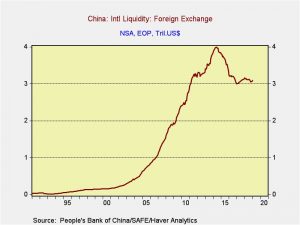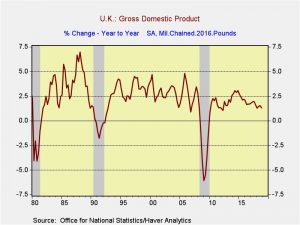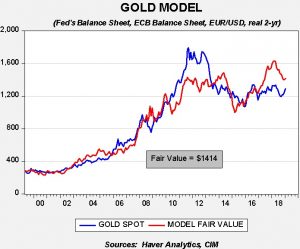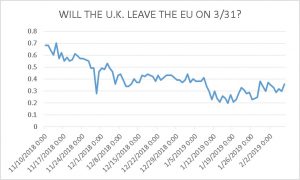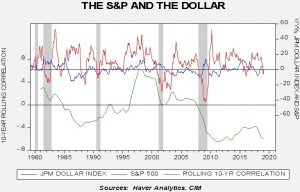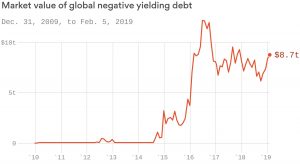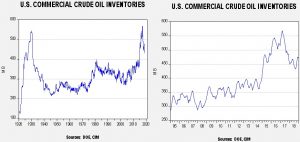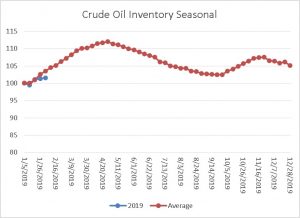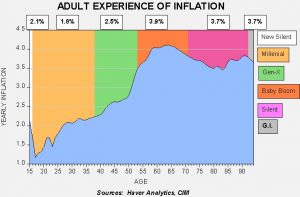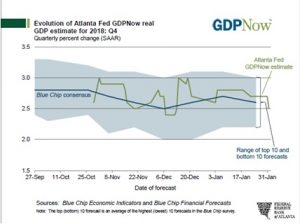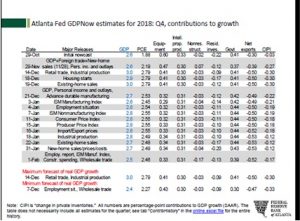by Bill O’Grady and Thomas Wash
[Posted: 9:30 AM EDT] U.S. equity futures are trending higher this morning after a mostly flat day yesterday. The big news is that negotiators have reached a deal to avoid a government shutdown. Here is what we are watching this morning:
Shutdown averted: Negotiators have reached a deal to avoid a government shutdown which would have occurred Friday night without action. The deal does not give the president the funding he asked for with regard to a border wall. Although there are some doubts he will sign the bill, we expect him to sign it and then try to shift funds from other sources or declare a national emergency to get the wall built.[1]
Some commentators are suggesting today’s rally was driven by the budget deal. Perhaps; however, the shutdown didn’t have a strong negative impact on financial markets so it seems a bit of a stretch to presume the avoidance of a shutdown brought support. However, avoiding a shutdown does remove a potential negative factor for the economy and thus is good news.
Italy and gold reserves: Matteo Salvini, the head of the League and deputy PM, proposed yesterday that the government should seize gold reserves held at the Bank of Italy and use them for spending. Italy holds the world’s third largest official gold reserves, around 2,451.8 tonnes, or about $102.5 bn. It is a sizable amount of money, about 20% of GDP. The populist government has been attacking the independence of the Bank of Italy,[2] a common action by populists. In general, populists represent the debtor class which benefits from cheaper money. It is not clear if such a move is legal but it raises serious questions about the reaction from the EU and Germany; under normal circumstances, a massive gold liquidation such as this would tend to undermine a currency’s exchange rate. However, because Italy is a member of the Eurozone, it isn’t obvious if the EUR would weaken on the news. Nevertheless, the psychological threat to the EUR would likely raise German worries about currency stability. In one sense, such a sale shouldn’t matter. If it is nothing more than an asset sale, one would not expect the currency to weaken. After all, if a government privatized a state-owned asset (e.g., government-owned utility) it wouldn’t usually depress the exchange rate. But, gold sales have the look of selling the family jewels; when I did country risk for an international bank we viewed gold sales as an indicator of future default. Although the government’s intention to sell looks more like a way to boost government spending, in reality, a gold sale will rattle Eurozone confidence and lower gold prices as well.
Chinese debt worries: It appears that two large Chinese private borrowers missed payments this month, raising fears of more widespread credit problems in China.[3]
Tax refunds fall: Last year, the Trump administration pressed the IRS to adjust withholding tables so that households would see an immediate impact on their weekly paychecks. Now, that action is having the perverse impact of reducing tax refunds. Although a tax refund is, in reality, clear evidence of financial mismanagement (it’s an interest-free loan to the government), many households use the tax refund as a form of saving. A reduction could show up as reduced consumption in Q2 and Q3. Refunds thus far are down a bit over 8% compared to last year.[4]
Catalan trial begins: Yesterday, we noted that Spain’s PM is facing a crisis over Catalan. Sanchez indicated he would appoint a mediator between the central government and separatists. This has triggered a firestorm[5] that threatens to bring down Sanchez’s minority government.[6] Today, the government begins a trial against leaders of the Catalan separatists, which could bring down the Sanchez government.[7] For background on this issue, we have footnoted two Weekly Geopolitical Reports.[8]
A Canadian scandal: Canada’s parliamentary ethics commissioner is investigating allegations that PM Trudeau pressed his former attorney general to end a criminal investigation against a large Canadian engineering company, SNC-Lavalin (SNCAF, USD, 25.61). The allegations include bribery by the company tied to the former regime in Libya.[9] The company is a major employer in Quebec and an investigation is raising fears in the separatist province. Canadian elections will be held this autumn and we would expect the opposition to use this against the PM. The CAD is already under pressure due to fears of a NAFTA breakdown and weakening world growth. A political crisis could add further pressure on the exchange rate.
Saudi Aramco goes international? The state oil company of Saudi Arabia announced plans to expand investments into the world.[10] During its history, Saudi Aramco has focused on the massive oil reserves within the kingdom, although it does own downstream assets around the world. It is unclear why the Saudis are making this move now. One possibility is that Saudi Arabia’s oil fields may be depleted to a point that costs are rising.[11] If the Saudis are facing production constraints it is potentially a very bullish factor for oil.
White House presses Iraq to stop buying Iranian oil: The Trump administration is pushing Iraq to stop buying energy from Iran. This is unlikely to happen. Iraq needs Iranian oil products to maintain electric service and transportation and, given Iran’s influence on Baghdad, the odds are low that Iraq would comply with U.S. wishes. It is uncertain how hard the U.S. will pressure Iraq on its relations with Iran. However, without a significant increase in American military presence and investment, it is doubtful the U.S. can prevent Iraq from buying Iranian natural gas and oil.[12]
And, finally:A Federal Reserve research report confirms that globalization has flattened the Phillips Curve.[13] We would tend to agree with that assessment.
[1] https://www.washingtonpost.com/business/economy/top-lawmakers-meet-to-revive-stalled-border-talks-with-shutdown-days-away/2019/02/11/3cd0fc1a-2dff-11e9-813a-0ab2f17e305b_story.html?utm_term=.f5fb8e10f9b1 and https://www.nytimes.com/2019/02/11/us/politics/shutdown-deal.html
[2] https://www.ft.com/content/949d2c08-2d1d-11e9-8744-e7016697f225
[3] https://www.caixinglobal.com/2019-02-11/two-large-chinese-borrowers-are-said-to-miss-bond-payments-101378392.html
[4] https://finance.yahoo.com/news/the-first-wave-of-tax-refunds-are-down-8-on-average-181001645.html
[5] https://www.politico.eu/article/spains-right-wing-parties-protest-government-talks-with-catalan-nationalists-pedro-sanchez/?utm_source=POLITICO.EU&utm_campaign=31b984c7e7-EMAIL_CAMPAIGN_2019_02_11_05_48&utm_medium=email&utm_term=0_10959edeb5-31b984c7e7-190334489 and https://www.nytimes.com/2019/02/10/world/europe/madrid-protest-spain-catalonia.html?emc=edit_mbe_20190211&nl=morning-briefing-europe&nlid=567726720190211&te=1
[6] https://www.politico.eu/article/spain-pedro-sanchez-faces-backlash-over-catalan-secessionists-concession/?utm_source=POLITICO.EU&utm_campaign=31b984c7e7-EMAIL_CAMPAIGN_2019_02_11_05_48&utm_medium=email&utm_term=0_10959edeb5-31b984c7e7-190334489
[7] https://www.nytimes.com/2019/02/11/world/europe/catalonia-separatists-trial.html?emc=edit_mbe_20190212&nl=morning-briefing-europe&nlid=567726720190212&te=1
[8] See WGRs, The Situation in Catalonia: Part I (11/6/2017) and Part II (11/13/2017).
[9] https://www.nytimes.com/2019/02/11/world/canada/justin-trudeau-snc-lavalin-ethics-bribery.html?emc=edit_mbe_20190212&nl=morning-briefing-europe&nlid=567726720190212&te=1
[10] https://www.ft.com/content/e0a6775c-2e4f-11e9-ba00-0251022932c8
[11] The uncertainty surrounding Saudi oil reserves has developed a cottage industry of sorts. A good book, though a bit dated, is by Matthew Simmons. Simmons, M. (2005). Twilight in the Desert: The Coming Saudi Oil Shock and the World Economy. Hoboken, NJ: John Wiley & Sons.
[12] https://www.nytimes.com/2019/02/11/us/politics/iraq-buying-energy-iran.html?emc=edit_mbe_20190212&nl=morning-briefing-europe&nlid=567726720190212&te=1
[13] https://www.federalreserve.gov/econres/feds/files/2019007pap.pdf



